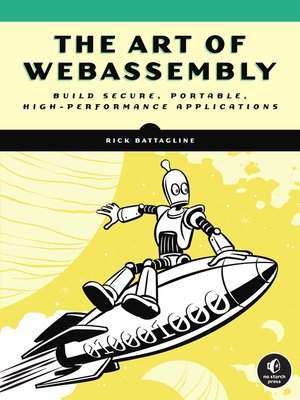The Art of WebAssembly
ebook ∣ Build Secure, Portable, High-Performance Applications
By Rick Battagline

Sign up to save your library
With an OverDrive account, you can save your favorite libraries for at-a-glance information about availability. Find out more about OverDrive accounts.
Find this title in Libby, the library reading app by OverDrive.



Search for a digital library with this title
Title found at these libraries:
| Library Name | Distance |
|---|---|
| Loading... |
A a thorough, practice-based introduction to WebAssembly. Learn how to create high-performing, lightning-fast websites and applications.
WebAssembly is the fast, compact, portable technology that optimizes the performance of resource-intensive web applications and programs. The Art of WebAssembly is designed to give web developers a solid understanding of how it works, when to use it (and when not to), and how to develop and deploy WebAssembly apps.
First you’ll learn how to optimize and compile low-level code, debug and evaluate WebAssembly, and represent WebAssembly in the human-readable WebAssembly Text (WAT) format. Once you have the basics down, you’ll build a browser-based collision detection program, work with browser rendering technologies to create graphics and animations, and see how WebAssembly interacts with other web languages.
You’ll also learn how to:
Embed WebAssembly applications in web browsers and Node.js Use browser debuggers to evaluate your WebAssembly code Format variables, loops, functions, strings, data structures, and conditional logic in WAT Manipulate memory Build a program that generates graphical objects and detects when they collide Evaluate the output of a WebAssembly compiler
The Art of WebAssembly will help you make sense of this powerful technology to boost the performance of your web applications.
WebAssembly is the fast, compact, portable technology that optimizes the performance of resource-intensive web applications and programs. The Art of WebAssembly is designed to give web developers a solid understanding of how it works, when to use it (and when not to), and how to develop and deploy WebAssembly apps.
First you’ll learn how to optimize and compile low-level code, debug and evaluate WebAssembly, and represent WebAssembly in the human-readable WebAssembly Text (WAT) format. Once you have the basics down, you’ll build a browser-based collision detection program, work with browser rendering technologies to create graphics and animations, and see how WebAssembly interacts with other web languages.
You’ll also learn how to:
The Art of WebAssembly will help you make sense of this powerful technology to boost the performance of your web applications.







